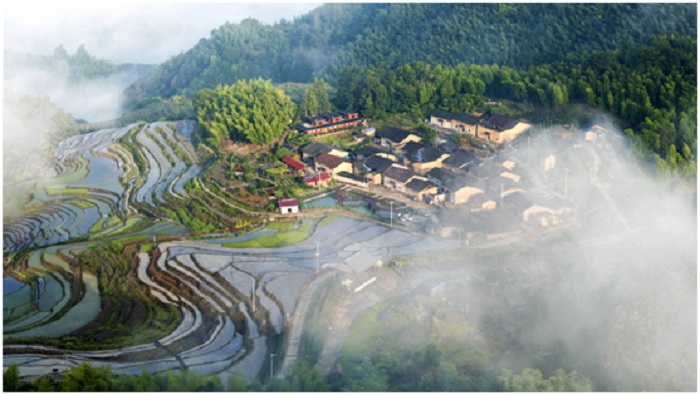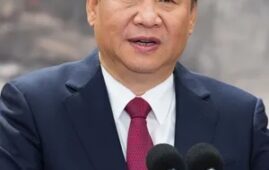



An innovative eco-bank mechanism is now reorganizing the natural resources of Nanping, Southeast China’s Fujian Province, paving a path of green development for the city.
Nanping is a city that enjoys superior ecological environment. With a forest coverage rate of 78.29 percent, the area of its farmland and forests accounts for a quarter of Fujian’s total, and around one third of the province’s forest stock comes from the city.
“The eco-bank mechanism, using the banking system as a reference, integrates fragmented natural resources and makes them into quality assets after large-scale renovation. These resources are handed over to professional operators for marketing and project matching, so a platform that turns resources into assets and capital is thus established,” explained Wang Chong, head of Nanping’s bureau of natural resources.
Guangze county, located along the upper stream of the Minjiang River in Nanping, has a total of nearly 4.3 billion cubic meters of surface water. Thanks to the eco-bank mechanism established two years ago, the county’s abundant and high-quality water resources had a clear “account bill.”
“The integration of the natural resources aims to have a thorough grasp of these resources and set ‘prices’ for the lush mountains and lucid waters,” said Chen Zhengwen, director of Guangze county’s water conservancy bureau. Through the eco-bank mechanism, the county made a map of water resources covering all of its territory where, apart from river systems, all the reservoirs and mineral water sites, as well as their planned usages are marked.
The map pointed a clear direction for future industrial development. A water conservancy investment company of the county, as an operator of the eco-bank mechanism, sorted a batch of high-return and easy-to-implement projects that were closely related to water resources, and established a transaction platform that turned scattered and fragmented natural resources and assets into green industries.
“The high-quality water resources are gradually creating economic benefits,” said Chen. The county has introduced a company from East China’s Zhejiang Province in the sports industry, and is planning to build three reservoir fishing bases and five creek fishing bases. The county hopes to build itself into a famous town of fishing by holding fishing events and games.
Shunchang county, another county of Nanping, has 1,667 square kilometers of forests that cover 76 percent of the county’s land. Therefore, the county resorted to forest eco-bank.
Xia Liuhua is living in Shunchang’s Shuinan village. Her husband is handicapped, and her daughter works out of town all year round, so her 0.6 hectares of firs were left unattended. Fortunately, when Shunchang’s forest eco-bank was opened in December 2018, Xia became one of its first batch of “clients”. After signing an agreement with the bank and entrusting her firs, she can receive 3,720 yuan ($530) from the bank on an annual basis in the following 20 years. Twenty years later, she can also get 60 percent of the sales revenue after deduction of management costs based on the actual value of the firs.
Many villagers have entrusted their woods to the bank like Xia did. The bank, through integrating the resources and developing forestry economy, can increase the stock volume per mu (667 square meters) by 50 percent.
According to statistics, the forest eco-bank of Shunchang county has issued over 200 million yuan of loans against forest rights, and 5,333 hectares of woodlands have been pledged. The total value of the county’s forestry hit 4.57 billion yuan last year, with a forestry fixed asset investment of 93.2 million yuan.
Apart from Guangze and Shunchang, many other places in Nanping are also exploring ways of development according to their featured natural resources. Jianyang district established an eco-bank for the industry of Jian teacup, a traditional Han nationality porcelain. By figuring out the total reserve of ceramic clay and kaolinite, the raw materials for making Jian teacups, the district has drawn a map of the distribution of these materials. Wufu township of Wuyishan built a cultural eco-bank, and for the first time completed the ownership registration for its cultural resources and had a thorough investigation of the ecological resources in 11 incorporated villages.
At present, the impetus of green development is getting increasingly stronger in Nanping. In 2019, the revenues of the city’s green agriculture, advanced manufacturing and tourism sectors all exceeded 60 billion yuan, and green industries contributed 89.9 percent to the city’s industries above designated size.


Cooperation between China and Nigeria had.



Nigerian government has urged trainees of.



Minister of State for Foreign Affairs,.


The Nigerian Government has congratulated the.


The Humanitarian Service Diamond Awards has.
A Chinese Company, Inner Galaxy Steel.


The Programme Coordinator, Regulatory, Compliance and.


A Non-Governmental Organization (NGO), Committee for.
The Trustfund Pensions Limited has chided.


The House of Representatives Committee on.
Leave a Comment